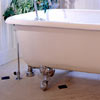Laminated Flooring
In recent years, laminated wood flooring has soared in popularity. Laminated flooring has a 1/8-inch layer of hardwood bonded to two layers of less costly wood backing, reducing the amount of expensive hardwood needed. Almost all laminate floors have a triple warranty against wearing, staining and fading; a 15-year warranty against all three isn't uncommon. Some companies are now adding moisture warranties for their products.
In addition to wood floor specalists, many carpet, tile or vinyl flooring professionals can help you install laminate floors. Laminate flooring is easy to install because, unlike conventional solid wood, it's pre-finished and may be glued down or applied over a thin foam pad laid on the subfloor. Some types are adhesive backed.
 Another advantage of laminated flooring materials is that they're less likely to suffer from the expansion and contraction problems that often occur in moisture-prone areas, such as bathrooms and kitchens.
Another advantage of laminated flooring materials is that they're less likely to suffer from the expansion and contraction problems that often occur in moisture-prone areas, such as bathrooms and kitchens.
Its thickness gives solid-wood flooring an advantage over a laminated one. Solid-wood flooring may be sanded and refinished numerous times. Laminated floors have a surface layer that's no more than 1/8 inch thick. Once this goes, the floor goes. Most of today's hardwood floors are coated with urethanes and acrylics that are durable, water-resistant and require very little care.
Laminate damage: Let your service professional know exactly what kind of damage has been done to your laminated floor. There are tools to repair laminate problems -- scratching, discoloration, scuff marks, cracks and burns. If too much glue was applied to the floor, the planks could come apart. They might also not fit together well if the tongues have been damaged. Planks also might be loosened because of irregularities in the subflooring.
Matching laminate material: If you have extra laminate materials left from the original installation, the service professional might be able to make the repair without having to try and match up new material with the original laminate.
Subfloor: The support layer between the floor joists and the finished floor. It serves as a platform during construction and then provides a base for the finish flooring.
Most laminated floors are installed over plywood subflooring, but they can also be applied to a smooth concrete slab or a sound existing vinyl floor.
-- Tips courtesy of HomeAdvisor.com